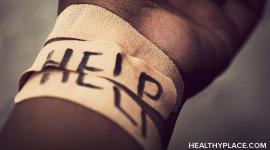Why Pro Self Injury, Pro Self Harm Websites Are Dangerous

Pro self-injury websites represent the dark side of the Internet. These websites provide visitors with different ways to self-harm and ideas about how to hurt themselves and keep their activities hidden from parents and friends. Some pro self-harm sites offer information about how to successfully commit suicide (self-harm and suicide).
Speaking Out Against Sites with Pro Self Injury Agenda
The following video features a young man who regularly visited and engaged with others on a pro self-injury website. He talks about the secretive theme of these sites and how those who ran the web page claimed they cared about teens and others who wanted to purposely injure themselves. But rather than helping their members and visitors find self-injury help and support, they actually gave them new ideas on how to commit suicide, sending them deeper into depression and a culture of self-harm.
Some websites with a pro self-injury or pro self-mutilation agenda also promote eating disorders like anorexia and bulimia. Many refer to these as pro-ana and pro-mia sites, but devotees call them thinspiration or thinspo blogs. Subscribers and members to these sites learn self-starvation and purging techniques. Some photo-based thinspo websites display ghoulish photographs of their members, many displaying a starting, current, and ultimate goal weight above or below the images.
Pro self-harm websites actively distribute information and techniques that encourages readers to engage in activities that could result in permanent damage to health and wellbeing, or result in death.
Pro Self Harm Sites Target Vulnerable
The dangerous and disturbing agenda of these and other Internet havens for pro self-injury has not gone unnoticed. The executives in charge of the popular blogging platform, Tumblr, took a stand against blogs that are pro self-harm in February 2012 by banning websites on Tumblr that offer information promoting self-injury and suicide. The ban sparked a fervent debate and Tumblr backed off from the initial wording of the declaration, but has ultimately stood by their new content policies. Since then, other popular social media platforms, such as Pinterest and Instagram, have followed suit.
Sites with pro self-injury and pro self-harm agendas target vulnerable people, like teens and young adults, but their reach extends far beyond the self-injurer him- or herself. When a person suffers irreparable physical or mental damage as a result of following the advice on these sites, the harm extends outward in a concentric fashion affecting parents, siblings, extended family, friends, and even strangers. The truth is - the sooner a person gets treatment for self-injury, the better chance they have for a long-lasting recovery.
APA Reference
Gluck, S.
(2021, December 24). Why Pro Self Injury, Pro Self Harm Websites Are Dangerous, HealthyPlace. Retrieved
on 2025, April 15 from https://www.healthyplace.com/abuse/self-injury/why-pro-self-injury-pro-self-harm-websites-are-dangerous


